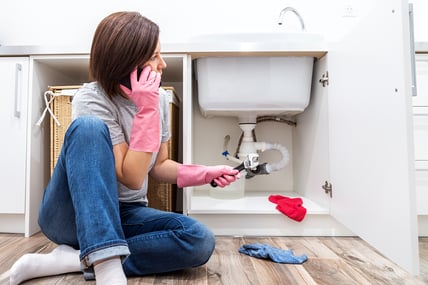“This is the last thing I need before we go on our annual vacation,” a client told me last week, upset after dealing with a burst frozen water pipe.
Yes, a plumbing emergency can strike at any time, often at the worst times. Nonetheless, plumbing emergencies are always stressful situations that leave homeowners feeling frustrated and anxious about what to do next.
An Emergency Plumber to the Rescue… But Not Only That
While calling an emergency plumber is the typical response, homeowners can still take actions while waiting for the professional to arrive – steps that plumbers appreciate, as they show initiative on the homeowner's part.
The good news is that none of these steps require any plumbing tools, knowledge, or skills. Here are six easy steps that any plumbing-dummy homeowner can take while waiting for an emergency plumber.
The Emergency Plumber Hasn't Arrived Yet? Here's What You Should Do in A Plumbing Emergency
Turn Off the Water Supply
The first step in any plumbing emergency is to shut off the main water supply. This will prevent additional water from flowing into the affected area and causing more damage. Locate the main water shut-off valve, which is typically near the water meter, basement, or sometimes even under the kitchen sink. Use a wrench to turn the valve clockwise to shut off the water supply completely.
Turn Off the Electricity
If the plumbing emergency involves electrical appliances or outlets near water (for example, a leaky refrigerator, dishwasher, or laundry machine), turn off the electricity from the fuse box or circuit breaker panel. This crucial step reduces the risk of electrical shock and potential fire hazards.
Let Water Run
After shutting off the water supply, open all the faucets in your house, including cold and hot taps, outside garden spigots, and even flush the toilet. This action helps relieve any remaining pressure in the plumbing system and drains excess water, reducing the risk of further leaks.
Clear the Area
It would greatly help the plumber if they had clear and easy access to the plumbing emergency area. So, while you are waiting for the plumber to arrive, use the time to move away furniture, decor, and other items to a safe and dry location. This not only enables prompt access to the issue for the plumber but also saves time and money, especially if you're being charged by the hour.
Document the Damage
As the area is clear from obstructions, and before it is clean of excess water, it’s time to get your evidence. Specifically, take pictures and videos of the leak and take written notes to record any visible damage to walls, floors, and belongings. Try to be as descriptive and accurate as possible, including when and for how long the water is flowing, and make guesses about the cause. This documentation will be helpful for insurance claims, if necessary, and will provide the plumber with a clear understanding of the situation.
Take Damage Control Measures
If you can identify the source of the leak, it’s recommended that you try to contain it to avoid further damage by water sipping into your home's foundation. You can use pipe clamps, towels, plumber’s tape, or electrical tape to wrap around the leaking pipe. If there is a minor flood, try to soak it with dry cloths.
An Emergency Plumber, 24/7
A plumbing emergency can be stressful, but proactive steps can minimize damage. At Ken's Plumbing, we're available 24 hours a day, seven days a week, to handle any plumbing emergency quickly. Our experienced team is equipped to resolve burst pipes, clogs, and more.
So don’t wait long! Schedule service online or call us at (864) 242-5511. Trust Ken's for all your plumbing needs, and enjoy peace of mind knowing your home is in good hands.

.png)